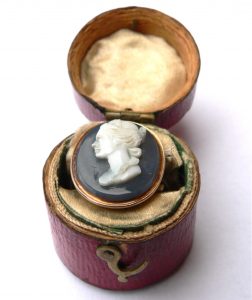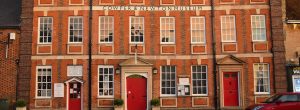Today we casually toss away our used tissues into a waste bin. If you lived in Georgian times handkerchiefs and their flirty language were the height of fashion. Handkerchiefs were both an ostentatious demonstration of wealth and a means of communicating with the person of your desire. So how did a humble piece of cloth gain such importance to a lady’s or gentleman’s attire?
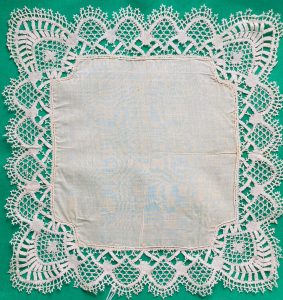
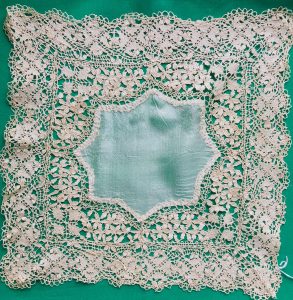
From Kerchief to Hand-kerchief
The first historical evidence of the kerchief was found in archeological artefacts from 1000 BC China. Small figures from the Zhou dynasty were found holding pieces of cloth thought to be for the purpose of shielding their heads from the hot sun. Later the Romans waved a square cloth at public events and started races with the drop of a scarf. In Europe, in the middle ages, knights tied a lady’s scarf to their helmet as a good luck talisman. Kerchiefs were also found in the Middle East and in cultures across the world. It is most likely therefore that the humble hankie arose in different places at the same time. All through the middle ages the kerchief was thought of as a head covering. In the fourteenth century courtiers for King Richard III mention him using a small square cloth for wiping his nose. To distinguish the cloth used for a head covering from that used for blowing your nose the term hand-kerchief developed, and by Elizabethan times the handkerchief was in common usage.
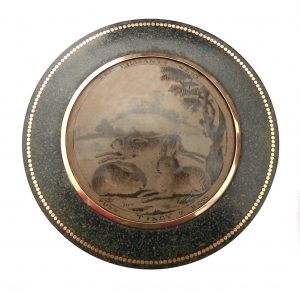
Hankies and Snuff
In the 18th century the taking of snuff for pleasure became highly popular among European royalty and aristocracy. Its popularity grew and spread among both men and women and was adopted by all levels of society. One problem for snuff takers is that the snuff leaves a brown residue around the nostrils, it also makes you sneeze! As the use of snuff increased, the demand for darker handkerchiefs with designs which hid the snuff stains became more popular. These darker hankies were hidden away in in the owner’s pockets to hide the snuff stains.
A Sign of Wealth
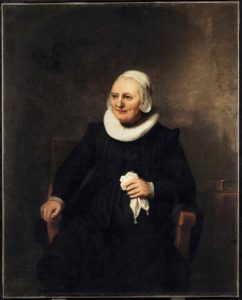
Art Gallery of Ontario
In the fifteenth century, European traders returned from China with great numbers of peasants’ headscarves, which Europeans appropriated as fashion accessories. Renaissance portraits show both men and women holding handkerchiefs embroidered and edged in lace. Handkerchiefs became hugely popular among the aristocracy and were considered so valuable that they were often part of a dowry and were bequeathed in wills. The loss of a handkerchief was sometimes mentioned in local publications. Handkerchiefs became larger and larger until in 1785 King Louis XVI of France declared that nobody should have a hankie larger than his!
‘A Bundle of Handkerchiefs was dropped or lost by Robert Paterfew, Chapman, in Newcastle Upon Tyne, on 22nd February last, in the Sand-Hill. Whoever can give Notice of them to Robert Paterfew aforesaid so they may be had again shall have a Guinea Reward.’
Newcastle Courant Monday 17 March 1712

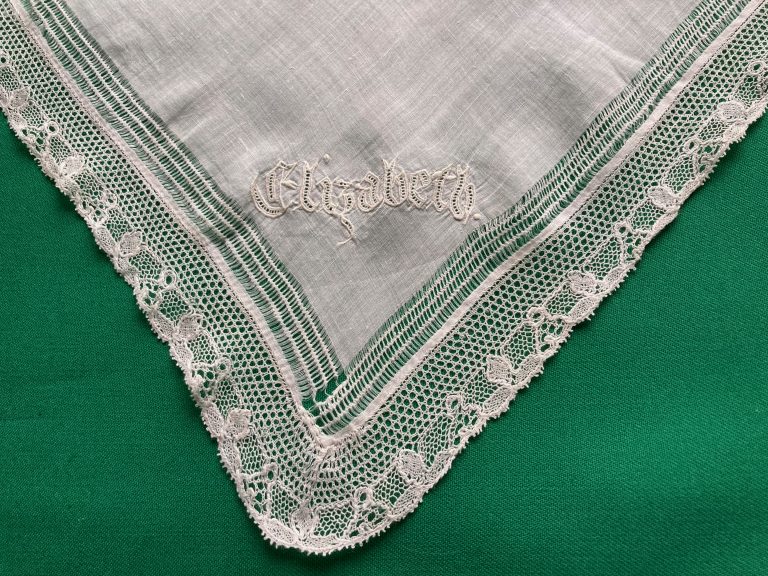
Elizabeth I
Elizabeth I was a great lover of handkerchiefs and she carried hankies embroidered with gold and silver thread. During her reign small handkerchiefs were popular gifts given as a sign of affection.
The sixteenth-century historian John Stowe provides a description of these tokens.
It was the custome for maydes and gentlewomen to give their favourites, as tokens of their love, little Handkerchiefs, of about three or four inches square…with a button or tassel at each corner, and a little one in the middle, with silke and threed; the best edged with a small gold lace, or twist, which being doubled up in foure crosse foldes, so as the middle might be seene, gentlemen and others did usually wear them in their hattes, as favours of their loves and mistresses.
Elizabeth loved handkerchiefs and gave as many as she received. The importance of hankies at this time is illustrated through a story involving Elizabeth. On one occasion she was watching two of her male courtiers playing tennis. One of them grabbed Elizabeth’s handkerchief to mop his sweaty brow. His opponent was incensed by this behaviour, declaring it ‘too saucy’, and a fight ensued.
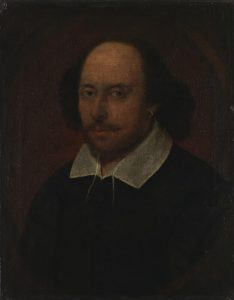

Shakespeare, Othello and the handkerchief
Shakespeare used a handkerchief as a central plot device in Othello, helping to weave the whole story together. For Othello it symbolises his love and devotion to Desdemona, his wife, and in turn the fidelity she owes to him. His mother had told him to give it to his wife as a sacred token when he married. As he says to Desdemona,
That handkerchief
Did an Egyptian to my mother give…
…She, dying, gave it me;
And bid me, when my fate would have me wive,
To give it her. I did so: and take heed on’t;
Make it a darling like your precious eye;
To lose’t or give’t away were such perdition
.As nothing else could match.
It is when Othello believes that the handkerchief has been given to another man that he is driven into an ill-fated rage with devastating consequences.
Bedfordshire spider pattern. Harry Armstrong Catalogue
1911
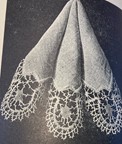
Find out more about Harry Armstrong in this article on the Olney & District History Society website

Flirty language of the handkerchief.
Elizabeth I used her hankies to give silent signals and messages to her courtiers and servants. Was this how the ‘flirty’ language of the handkerchief developed? Certainly these court signals became well understood so it is possible that another more flirtatious code of signals developed.
Throughout the Georgian, Regency and Victorian periods women could not flirt openly due to the extreeme social attitudes of the time. Society wholeheartedly disapproved of any overt sexual advances so the only way a woman could communicate her intentions was through non verbal communication. Women could of course bat their eyelids or offer a knowing look but alongside this developed two coded signals, one code was with the use of a fan.* The other was with the use of the handkerchief.
In 1867, ‘The Handkerchief Telegraph’ was described in the Journal of the Telegraph published by the Western Union Telegraph Company.
Drawing it across the cheek — I love you.
Drawing it across the eyes — I am sorry.
Drawing it across the forehead — Look, we are watched.
Drawing it through the hands — I hate you.
Drawing it across the lips — Desiring an acquaintance.
Dropping it — We will be friends.
Folding it — I wish to speak with you.
Letting it rest on the left cheek — No.
Letting it rest on the right cheek — Yes.
Letting it remain on the eyes — You are so cruel.
Opposite corners in both hands — Do wait for me.
Over the shoulder — Follow me.
Placing it over the right ear — How you have changed.
Putting it in the pocket — No more love at present.
Taking it by the centre — You are most too willing.
Twisting it in the left hand — I wish to be rid of you.
Twisting it in the right hand — I love another.
Winding it around the forefinger — I am engaged.
Winding it around the third finger — I am married.
In 1877 Daniel R. Shafer described how the handkerchief was used.
‘The handkerchief, among lovers, is used in a different manner than its legitimate purpose. The most delicate hints can be given without danger of misunderstanding, and in ‘flirtations’ it becomes a very useful instrument. It is in fact superior to the deaf and dumb alphabet, as the notice of bystanders is not attracted.’
Into 20th century
The use of handkerchiefs for communicating ones intentions gradually died out during Edwardian times as attitudes changed and had become obsolete by the end of the First World War. The mass production of handkerchiefs had also lead to their prime use for wiping a snuffly nose! However the ‘flu pandemic, which swept the world after the First World War, was still very recent history when Kleenex invented a paper tissue with the clever advertising slogan “Don’t carry a cold in your pocket”. In the course of the 20th century this lead to the dramatic decline in the use of a cloth hankie as the disposable tissue took its place.
Further Reading
* The Secret Language of Fans article by Alexandra Starp
The Contradictory Life of the Handkerchief blog post by Bella Mirabella
Considerations on a Handkerchief blog post by the Victoria & Albert Museum
The Handkerchief Telegraph article in the Journal of the Telegraph, Western Union Telegraph Company, 1867
The Nunnery for Coquettes, Printed for T. Lowndes 1771, p. v.
Stowe, John, The chronicles of England from Brute unto this present yeare of Christ. 1580. Collected by Iohn Stow citizen of London.
Shafer, Daniel R, Secrets of Life Unveiled, 1877, p. 231.


